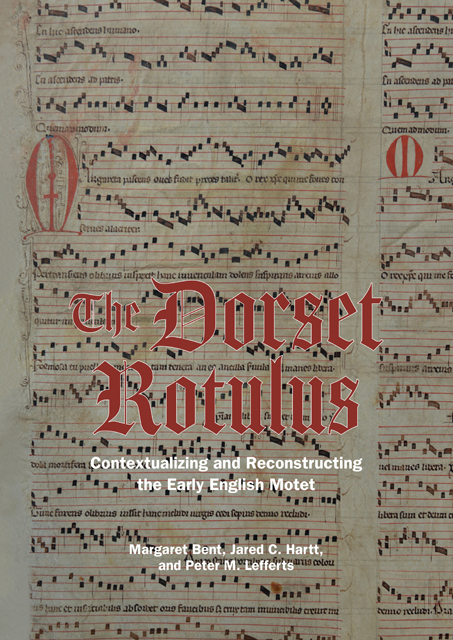Book contents
- Frontmatter
- Contents
- List of Figures
- List of Music Examples
- List of Tables
- Abbreviations
- Note on the Transcriptions
- Introduction
- 1 The Source and its Contents
- 2 Contexts and Designs
- 3 Voice-Exchange Motets and Ascendenti sonet geminacio/ Viri Galilei
- 4 Margareta pascens oves and its Large-Scale Comparands
- 5 Rota versatilis: Towards a Reconstruction
- 6 The Curious Case of Regina preminencie/ Gemma nitens/ … mater es intacta
- 7 Introducing Naufragantes visita/ Navigatrix inclita/ T. Aptatur/ … velox perpetrat
- 8 The Musical Rotulus: Artifact, Image, and Attributes
- 9 Epilogue: Conclusions and Speculation
- Appendix: Transcriptions, Texts, and Translations of the Four Dorset Motets
- Bibliography
- Index of Manuscripts
- Index of Musical Compositions
- General Index
- Studies in Medieval and Renaissance Music
2 - Contexts and Designs
Published online by Cambridge University Press: 14 January 2023
- Frontmatter
- Contents
- List of Figures
- List of Music Examples
- List of Tables
- Abbreviations
- Note on the Transcriptions
- Introduction
- 1 The Source and its Contents
- 2 Contexts and Designs
- 3 Voice-Exchange Motets and Ascendenti sonet geminacio/ Viri Galilei
- 4 Margareta pascens oves and its Large-Scale Comparands
- 5 Rota versatilis: Towards a Reconstruction
- 6 The Curious Case of Regina preminencie/ Gemma nitens/ … mater es intacta
- 7 Introducing Naufragantes visita/ Navigatrix inclita/ T. Aptatur/ … velox perpetrat
- 8 The Musical Rotulus: Artifact, Image, and Attributes
- 9 Epilogue: Conclusions and Speculation
- Appendix: Transcriptions, Texts, and Translations of the Four Dorset Motets
- Bibliography
- Index of Manuscripts
- Index of Musical Compositions
- General Index
- Studies in Medieval and Renaissance Music
Summary
Latin-texted motets of the late thirteenth and early fourteenth centuries from England are known from far more compositions – albeit often in fragmentary form – and from far more manuscript sources than contemporaneous Latin motets found on the continental mainland. They play a prominent role in the history and development of the motet in its various manifestations and offer modern performers and scholars attractive works demonstrating a high level of individualization and innovation. And yet, the history of the medieval motet in this period has been written with an implicit bias that traces almost exclusively the French and Latin motets found in continental sources. In this light, the discovery of the Dor rotulus becomes a timely spur to fresh consideration of some aspects of the Latin-texted motet in England c. 1280–1320. After introductory comments about the motet as a type of composition, and some words about dating and the numbers of pertinent known motets, this chapter contextualizes certain features and developments of the Dor motets within the English motet corpus, and also within some contexts that incorporate contemporary motets from the continental mainland.
What is a Motet?
In order to identify which compositions in musical sources can be classified as motets, the place to begin is with a summary of their general characteristics as presented by contemporaneous medieval writers on music. The principal attributes of the polyphonic motet that they enumerate are that (1) it is written in two or more voices that proceed against one another, mainly by consonances, (2) it is musica mensurabilis (rhythmically and notationally measured in all voices), (3) it has a distinctive voice part – the tenor – that functions as a fundamentum and is often a cantus prius factus, and finally, (4) it is polytextual (cum diversis litteris), with the significant addendum that even the tenor may be a text-bearing voice.
Beyond the theorists’ initial attributes, we are aided by additional kinds of evidence. First, the music theory treatises often cite titles or musical incipits as examples and use the word ‘motet’ as an identifier. These cited motets can lead us to music manuscripts where they are found amongst groups of similar compositions. Further, there are surviving lists of contents for music manuscripts (for example, LoHa, Fauv, Trém) that use ‘motet’ to designate one or more series of pieces, all or some of which are surviving compositions.
- Type
- Chapter
- Information
- The Dorset RotulusContextualizing and Reconstructing the Early English Motet, pp. 27 - 56Publisher: Boydell & BrewerPrint publication year: 2021



